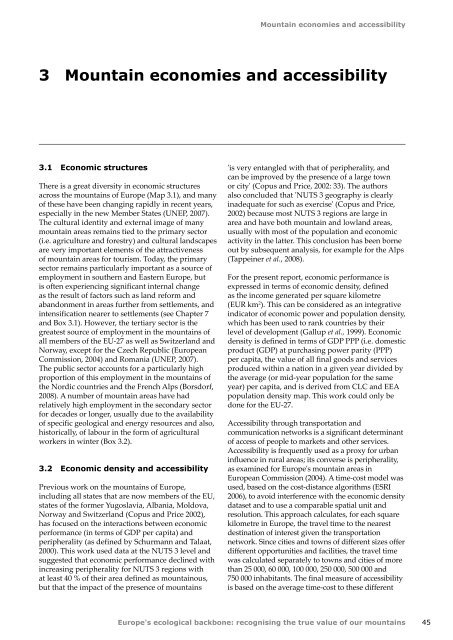Europes ecological backbone.pdf
Europes ecological backbone.pdf
Europes ecological backbone.pdf
Create successful ePaper yourself
Turn your PDF publications into a flip-book with our unique Google optimized e-Paper software.
Mountain economies and accessibility<br />
3 Mountain economies and accessibility<br />
3.1 Economic structures<br />
There is a great diversity in economic structures<br />
across the mountains of Europe (Map 3.1), and many<br />
of these have been changing rapidly in recent years,<br />
especially in the new Member States (UNEP, 2007).<br />
The cultural identity and external image of many<br />
mountain areas remains tied to the primary sector<br />
(i.e. agriculture and forestry) and cultural landscapes<br />
are very important elements of the attractiveness<br />
of mountain areas for tourism. Today, the primary<br />
sector remains particularly important as a source of<br />
employment in southern and Eastern Europe, but<br />
is often experiencing significant internal change<br />
as the result of factors such as land reform and<br />
abandonment in areas further from settlements, and<br />
intensification nearer to settlements (see Chapter 7<br />
and Box 3.1). However, the tertiary sector is the<br />
greatest source of employment in the mountains of<br />
all members of the EU‐27 as well as Switzerland and<br />
Norway, except for the Czech Republic (European<br />
Commission, 2004) and Romania (UNEP, 2007).<br />
The public sector accounts for a particularly high<br />
proportion of this employment in the mountains of<br />
the Nordic countries and the French Alps (Borsdorf,<br />
2008). A number of mountain areas have had<br />
relatively high employment in the secondary sector<br />
for decades or longer, usually due to the availability<br />
of specific geological and energy resources and also,<br />
historically, of labour in the form of agricultural<br />
workers in winter (Box 3.2).<br />
3.2 Economic density and accessibility<br />
Previous work on the mountains of Europe,<br />
including all states that are now members of the EU,<br />
states of the former Yugoslavia, Albania, Moldova,<br />
Norway and Switzerland (Copus and Price 2002),<br />
has focused on the interactions between economic<br />
performance (in terms of GDP per capita) and<br />
peripherality (as defined by Schurmann and Talaat,<br />
2000). This work used data at the NUTS 3 level and<br />
suggested that economic performance declined with<br />
increasing peripherality for NUTS 3 regions with<br />
at least 40 % of their area defined as mountainous,<br />
but that the impact of the presence of mountains<br />
'is very entangled with that of peripherality, and<br />
can be improved by the presence of a large town<br />
or city' (Copus and Price, 2002: 33). The authors<br />
also concluded that 'NUTS 3 geography is clearly<br />
inadequate for such as exercise' (Copus and Price,<br />
2002) because most NUTS 3 regions are large in<br />
area and have both mountain and lowland areas,<br />
usually with most of the population and economic<br />
activity in the latter. This conclusion has been borne<br />
out by subsequent analysis, for example for the Alps<br />
(Tappeiner et al., 2008).<br />
For the present report, economic performance is<br />
expressed in terms of economic density, defined<br />
as the income generated per square kilometre<br />
(EUR km 2 ). This can be considered as an integrative<br />
indicator of economic power and population density,<br />
which has been used to rank countries by their<br />
level of development (Gallup et al., 1999). Economic<br />
density is defined in terms of GDP PPP (i.e. domestic<br />
product (GDP) at purchasing power parity (PPP)<br />
per capita, the value of all final goods and services<br />
produced within a nation in a given year divided by<br />
the average (or mid-year population for the same<br />
year) per capita, and is derived from CLC and EEA<br />
population density map. This work could only be<br />
done for the EU‐27.<br />
Accessibility through transportation and<br />
communication networks is a significant determinant<br />
of access of people to markets and other services.<br />
Accessibility is frequently used as a proxy for urban<br />
influence in rural areas; its converse is peripherality,<br />
as examined for Europe's mountain areas in<br />
European Commission (2004). A time‐cost model was<br />
used, based on the cost-distance algorithms (ESRI<br />
2006), to avoid interference with the economic density<br />
dataset and to use a comparable spatial unit and<br />
resolution. This approach calculates, for each square<br />
kilometre in Europe, the travel time to the nearest<br />
destination of interest given the transportation<br />
network. Since cities and towns of different sizes offer<br />
different opportunities and facilities, the travel time<br />
was calculated separately to towns and cities of more<br />
than 25 000, 60 000, 100 000, 250 000, 500 000 and<br />
750 000 inhabitants. The final measure of accessibility<br />
is based on the average time‐cost to these different<br />
Europe's <strong>ecological</strong> <strong>backbone</strong>: recognising the true value of our mountains<br />
45

















